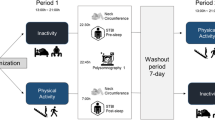Abstract
The aim of this study was to investigate the changes in arterial oxygen saturation (SaO2) of stroke patients during mealtime and whether duration of feeding (time to finish a meal) and mode of feeding (self-feed versus being fed) were associated with such changes. This study also investigated whether the consequence of aspiration pneumonia in the stroke patients was associated with SaO2 drops during mealtime. The findings of this study showed that stroke patients but not the controls had a small but significant SaO2 drop during meals (0.91%, IQR = 1.53%, p < 0.05 in being fed; 1.04%, IQR = 1.35%, p = 0.013, in self-feed). Duration of feeding and mode of feeding, however, did not have an association with mealtime SaO2 changes. The SaO2 drop during mealtime was not an early indicator of aspiration pneumonia.

Similar content being viewed by others
References
Good BC, Henkle JQ, Gelber D, Welsh J, Verhulst S. Sleep-disordered breathing and poor functional outcome after stroke. Sleep. 1996;27:252–9.
Rowat A, Wardlaw J, Dennis M. Changes in arterial oxygen saturation before and after enteral feeding tube insertion in dysphagic stroke patients. Age Ageing. 2004;33:42–5.
Silva Y, Serena J, Osuna T, Castellanos M, Suner R, Davalos A. Hypoxaemia as an early predictor of progressing stroke and poor outcome in the acute phase. Cerebrovasc Dis. 11(Suppl 4):70.
Roffe C. Hypoxaemia and stroke. Rev Clin Gerontol. 2001;11:323–335.
Nachtmann A, Siebler M, Rose G, Sitzer M, Stenimetz H. Cheyne-Stokes report on 128 patients. Neurology. 1995;45:820–1.
Haas A, Rusk HA, Pelosof H, Adam JR. Respiratory function in hemiplegic patients. Arch Phys Med Rehabil. 1967;48:631–2.
Bassetti C, Aldrich MS. Sleep apnea in acute cerebrovascular diseases: final report on 128 patients. Sleep. 1999;22:217–23.
Rogers BT, Arvedson J, Msall M, Demerath RR. Hypoxemia during oral feeding of children with severe cerebral palsy. Dev Med Child Neurol. 1993;35:3–10.
Rogers BT, Msall M, Shucard D. Hypoxemia during oral feedings in adults with dysphagia and severe neurological disabilities. Dysphagia. 1993;8(1):43–8.
Rowat AM, Wardlaw JM, Dennis MS, Warlow CP. Does feeding alter arterial oxygen saturation in patients with acute stroke? Stroke. 2000;31:2134–40.
Alexander CM, Teller LE, Gross JB. Principles of pulse oximetry, theoretical and practical considerations. Anesth Analg. 1989;68:368–76.
Severinghaus JW, Naifeh KH. Accuracy of response of six pulse oximeters to profound hypoxia. Anesthesiology. 1987;67:551–8.
Roffe C, Sills S. Hypoxia in patients with acute stroke. Age Ageing. 2000;29(Suppl 1):60.
Matsui T, Yamaya M, Ohrui T, Arai H, Sasaki H. Sitting position to prevent aspiration in bed-bound patients. Gerontology. 2002;48(3):194–5.
Tamura F, Shishikura J, Mukai Y, Kaneko Y. Arterial oxygen saturation in severely disabled people: Effect of oral feeding in the sitting position. Dysphagia. 1999;14:204–11.
Blom H, Mulder M, Verweij W. Arterial oxygen tension and saturation in hospital patients: effect of age and activity. BMJ. 1988;297(6650):720–1.
Green NPO, Stout GW, Taylor DJ. Transport: transport in plants, transport in animals. In: Soper R, editor. Biological science 2. 2nd ed. Cambridge University Press: Cambridge; 1990. p. 527.
Roffe C, Sills S, Halim M, Wilder K, Allen MB, Jones PW, et al. Unexpected nocturnal hypoxia in patients with acute stroke. Stroke. 2003;34:2641–5.
Colodny N. Effects of age, gender, disease, and multisystem involvement on oxygen saturation levels in dysphagic persons. Dysphagia. 2001;16(1):48–57.
Aslanyan S, Weir CJ, Diener HC, Kaste M, Lees KR. GAIN International Steering Committee and Investigators, Pneumonia and urinary tract infection after acute ischaemic stroke: a tertiary analysis of the GAIN International trial. Eur J Neurol. 11(1):49–53.
Kaufmann AM, Firlik AD, Fukui MB, Wechsler LR, Jungries CA, Yonas H. Ischemic core and penumbra in human stroke. Stroke. 1991;30:93–9.
Ramsey DJC, Smithard DG. Can pulse oximetry or a bedside swallowing assessment be used to detect aspiration after stroke? Stroke. 2006;37:2984–8.
Zaidi NH, Smith HA, King SC, Park C, O’Neill PA, Connolly MJ. Oxygen desaturation on swallowing as a potential marker of aspiration in acute stroke. Age Ageing. 1995;24:267–70.
Collins MJ, Bakheit AM. Does pulse oximetry reliably detect aspiration in dysphagic stroke patients? Stroke. 1997;28:1773–5.
Author information
Authors and Affiliations
Corresponding author
Rights and permissions
About this article
Cite this article
Chan, S.Y.P., Lo, R.S.K. Changes in Arterial Oxygen Saturation (SaO2) Before, During, and After Meals in Stroke Patients in a Rehabilitation Setting. Dysphagia 24, 77–82 (2009). https://doi.org/10.1007/s00455-008-9177-9
Received:
Accepted:
Published:
Issue Date:
DOI: https://doi.org/10.1007/s00455-008-9177-9




